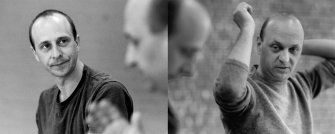Jonathan Burrows
Jonathan Burrows, coreografo e performer inglese, inizia la carriera nel Royal Ballet di Londra con cui danza per 13 anni, per poi fondare nel 1988 la propria compagnia. Oltre le collaborazioni con Jan Ritsema e Chrysa Parkinson, dal 1989 collabora stabilmente col musicista, compositore e performer Matteo Fargion. A partire da quell'anno la loro produzione di duetti continua ad essere presentata in tutto il mondo, incluse le recenti retrospettive a Lisbona, Porto, Philadelphia, e Bologna (Hysterical Furniture). Per tutto il 2016 Burrows, Fargion e il fotografo Hugo Glendinning sono stati impegnati nel progetto online lungo un anno 52 Portraits, lanciando ogni lunedì un ritratto gestuale di un danzatore. Tra le altre creazioni recenti: il duo Body Not Fit For Purpose, commissionato dalla Biennale Danza di Venezia, e una nuova installazione sulla volatilità della danza e la sue tracce nella mostra dell'archivio Derra De Moroda Dance Archive al Museum Der Moderne Salzburg. Il loro lavoro, tra musicalità, gesto e parola ritmica, coniuga rigore intellettuale e inaspettato umorismo, e affonda le radici nella passione condivisa per la musica classica, che i due artisti fanno collidere con un approccio performativo aperto alla relazione col pubblico, anarchico e gioioso. Tra le collaborazioni più prestigiose di Jonathan Burrows: Sylvie Guillem, William Forsythe e il Ballet Frankfurt, e il National Theatre di Londra. E' stato artista associato al Kunstencentrum Vooruit di Gent in Belgio, al South Bank Centre di Londra e Kaaitheater Brussels. Ha insegnato a P.A.R.T.S. Brussels e nelle università di Berlino, Gent, Giessen, Amburgo e Londra. Nel 2010 ha pubblicato il libro A Choreographer's Handbook (Routledge Publishing). Attualmente è Senior Research Fellow al Centre for Dance Research, Coventry University.
Jonathan Burrows, British choreographer and performer, danced with the Royal Ballet for 13 years, rising to the rank of soloist before leaving in 1991 to pursue his own choreography. After touring with his own company for some years, in 2001 he decided to concentrate on individual collaborations with other artists, who would share the conception, making, performing and administrating of the work. His first was Weak Dance Strong Questions (2001), made with Jan Ritsema. This was followed by a series of duets with composer and performer Matteo Fargion: Both Sitting Duet (2002), The Quiet Dance (2005), Speaking Dance (2006), Cheap Lecture (2009), The Cow Piece (2009), Counting To One Hundred (2011), One Flute Note (2012), Show And Tell (2013), Rebelling Against Limit (2013) and Body Not Fit For Purpose (2014). Burrows and Fargion have been working together since 1989, and their ongoing series of duets go on touring all around the world, with recent retrospectives in Lisbon, Porto, Philadelphia and Bologna (Hysterical Furniture). Their work is hard to place, combining intellectual rigour with unexpected humour, but it has its roots in a shared love of classical music, which they clash against an approach to performance that is at once open to audience but also anarchic and joyful. The two men also ran a year long online project called 52 Portraits releasing a different gestural portrait of a dancer every Monday throughout 2016. High profile choreographic commissions of Jonathan Burrows include Sylvie Guillem, William Forsythe’s Ballet Frankfurt, and the National Theatre London. Burrows has been an associate artist at Kunstencentrum Vooruit in Gent, Belgium, London’s South Bank Centre and Kaaitheater Brussels. He is a visiting member of faculty at P.A.R.T.S. Brussels and has also been guest professor at universities in Berlin, Gent, Giessen, Hamburg and London. In 2010 he published the book A Choreographer's Handbook (Routledge Publishing). Burrows is currently a Senior Research Fellow at the Centre for Dance Research, Coventry University.

